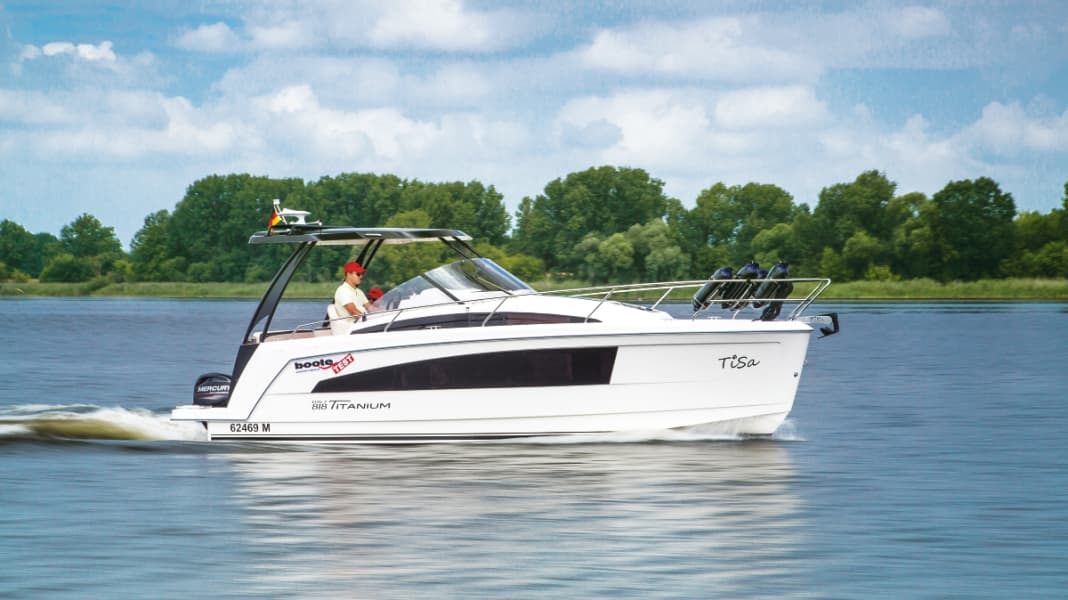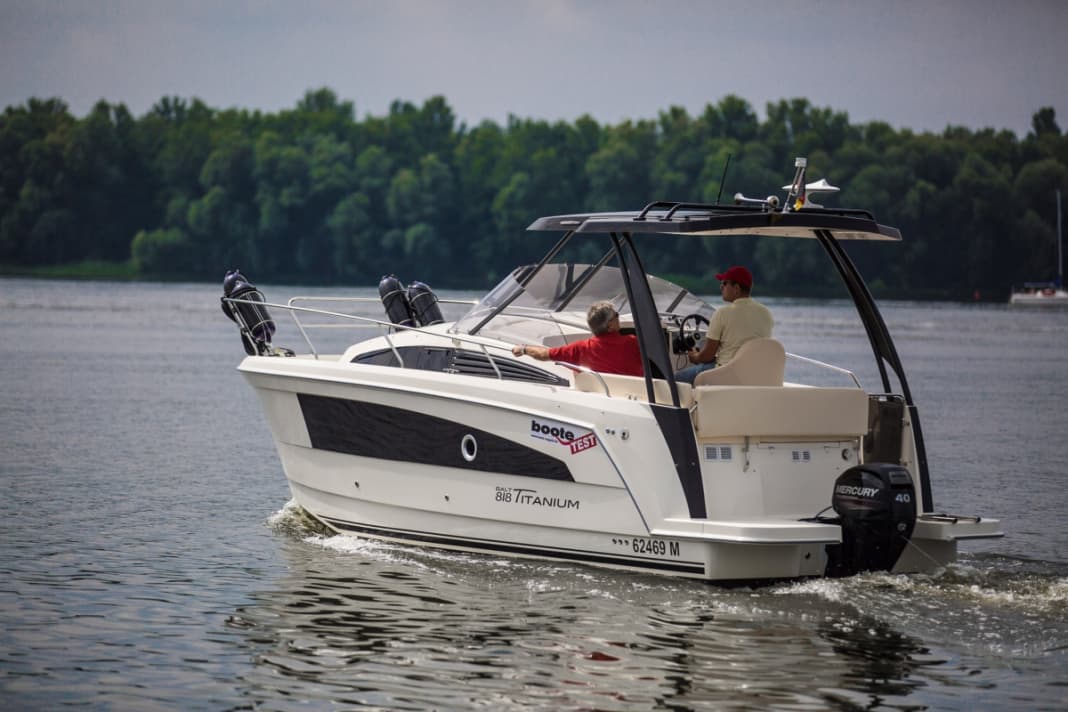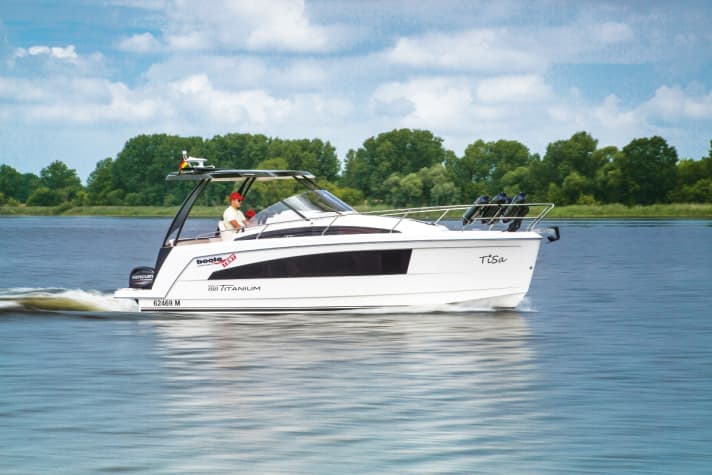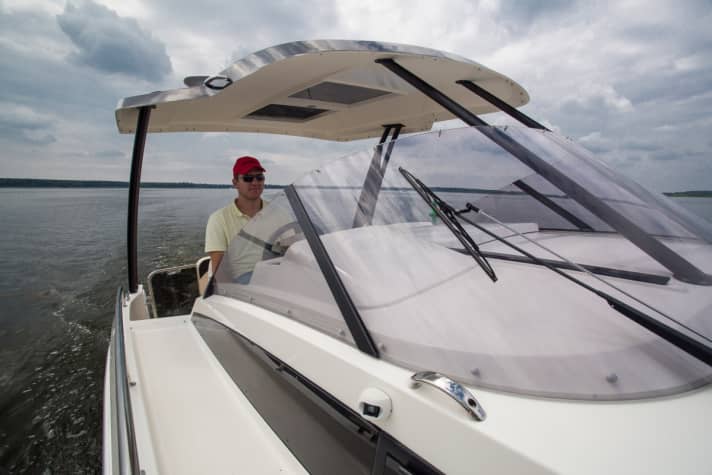







Not following the mainstream seems to be the Balt shipyard's credo, as our test boat, the Balt 818, already has a very unique look with its special hardtop. Another exotic boat from the Balt shipyard is the Suncamper 30 (see Boote 03/12). This is another boat that has been designed with the practicalities of life on board and a larger crew in mind.
Applied to the Titanium, this means six berths, a wet room, a pantry block, large side windows, a covered cockpit, a split bathing platform, a sun deck on the bow, side decks of different widths and free motorisation with a long-shaft outboard.
Driving and manoeuvring
Theoretically, a licence-free 15 hp version is also possible, but in this case the sailing area must not be too rough or affected by strong currents, as there is no reserve power available. The dealer equipped our test boat with a 40 hp Mercury outboard motor, which provides more power in critical situations and on long journeys. However, it does not manage to bring the Balt into the semi-planing range and thus switch to a faster gear. The shipyard recommends a speed of 13.5 knots, which can be achieved with a larger engine. A maximum of 90 hp is recommended. However, the owner deliberately opted for our weaker test engine, because you are not allowed to go fast on the waters around Brandenburg - where the boat is mainly used.
Anyone travelling this comfortably wants to consume as little fuel as possible, travel quietly and select the propeller so that the engine turns less. However, our test combination (engine/propeller) exaggerated this: At full throttle, we reached a maximum of 4300 rpm, which is far too low, as Mercury advises at least 5500 rpm for the four-cylinder engine. In the long run, the engine is overtaxed. This can be compared to a car that constantly drives up a steep hill in sixth gear.
We calculated an economic speed of 6 kn at 3000 rpm, which is just below the theoretical hull speed. One tank of fuel gives us a range of 120 nm plus 15% reserve, which is really impressive for this type of boat.
The course stability is proportional to the speed. The faster our test boat gets, the more stable the ride becomes. It's best to let it level out first and then only counter-steer a little so that you don't overshoot the target. It is noticeable that the rudder system (not installed by the shipyard) has some play and you are not particularly sensitive when travelling. The dealer Tino Böttcher has also recognised this and wants to improve this point.
Tight turning circles and direct turning behaviour are a guarantee for good manoeuvring. However, wind has a noticeable effect on manoeuvrability, and the bow thruster on the Balt 818, which is available at extra cost, proves to be a practical accessory. A propeller snapping air at 3500 rpm puts an end to fast reversing. Swell water is kept within limits and does not run into any openings or even into the cockpit. Fast, tight cornering is also unspectacular, with the Balt Titanium leaning moderately on the outside of the bend and gently swinging into its own wave.
The driver sits on a well-padded bucket seat, which can be adjusted in all directions, so that you can always find the optimum seating position. The steering wheel and gearstick are within easy reach from there. The cockpit bench seat installed lengthways to the direction of travel is ideal for the co-driver; the railing and windscreen frame provide support.

For a good view to the front, the co-driver has to look past the side of the cab roof or stretch to see through the windscreen. The latter is bolted to the underside and equipped with a sufficiently large windscreen wiper on the driver's side. The Smartcraft engine instruments can be read without obstruction in all driving positions. If you want to easily read the additionally installed plotter behind the steering wheel, it is best to stand up. The shipyard has installed easily accessible rocker switches with English labelling for switching on lights and the like.
The corresponding batteries, 2 x 100 Ah (on-board power supply) and 1 x 74 Ah (starter), are stored in plastic boxes with sturdy straps. Easily accessible main switches and fuses complete the 12 V system. Shore connection and charger are available for an extra charge. All three tanks are securely fastened in the boat and their lines and the entire installation are neatly and firmly laid. The only drawback is that there is only one screw clamp on some of the petrol hose connections.
Living and equipment
The largest berth of all is located below deck in the bow, followed by an underfloor berth up to the saloon berth, which is created from the seating group (four people) with a few handholds. However, this has dimensions that are only sufficient for two children. The cushions are comfortably firm, but there is no ventilation underneath. All crew members must also be aware that the rooms are only separated from each other by curtains.
The galley is located in the light-flooded saloon and has good equipment for this type of boat, sufficient storage space and a large work surface. The wet room with pump toilet (without holding tank as standard) and washroom is located aft. The room offers enough space for a 1.80 m tall person and a porthole for ventilation. A shower is not installed on our boat but, like the hot water boiler, can be ordered without any problems.
One floor up in the cockpit, the hardtop protects you from too much sun or rain. If you want to completely close off the space, you have to pay extra for the tarpaulin side panels. Sun worshippers go to the foredeck and bathers to the split platform with a long ladder. Access to the foredeck is easy via the starboard side deck, which is noticeably larger than the port side deck (0.28 m to 0.12 m).
Anti-slip structures ensure safe movement here, as does the sturdy railing, whose attachment points are expertly reinforced. In general, the workmanship of the boat makes a very good impression all round.
The boatyard provides four cleats as standard - however, the centre cleats on our boat, which are particularly useful for single-handed launching, are optional extras. We like the fact that the manual fire extinguisher and two electric bilge pumps are part of the equipment - the self-draining cockpit also provides a certain degree of safety, but if the power supply fails, only the manual bilge pump can help, although this is not standard. If you want to move the entire package on the road, you will need at least a 2.5 tonne trailer.
Conclusion
The Balt 818 Titanium has plenty of space for four people to go on cosy tours. However, the rooms are only separated by curtains, which limits privacy. The good workmanship and the special appearance should be emphasised.
Data sheet: Balt 818 Titanium
Shipyard: Balt-Yacht
Type designation: Balt 818 Titanium
CE category: C - Coastal waters
Material of hull and deck: Plastic
Length: 8,40 m
Width: 2,70 m
Displacement: 1,80 t
Price: 55.516,00 €

